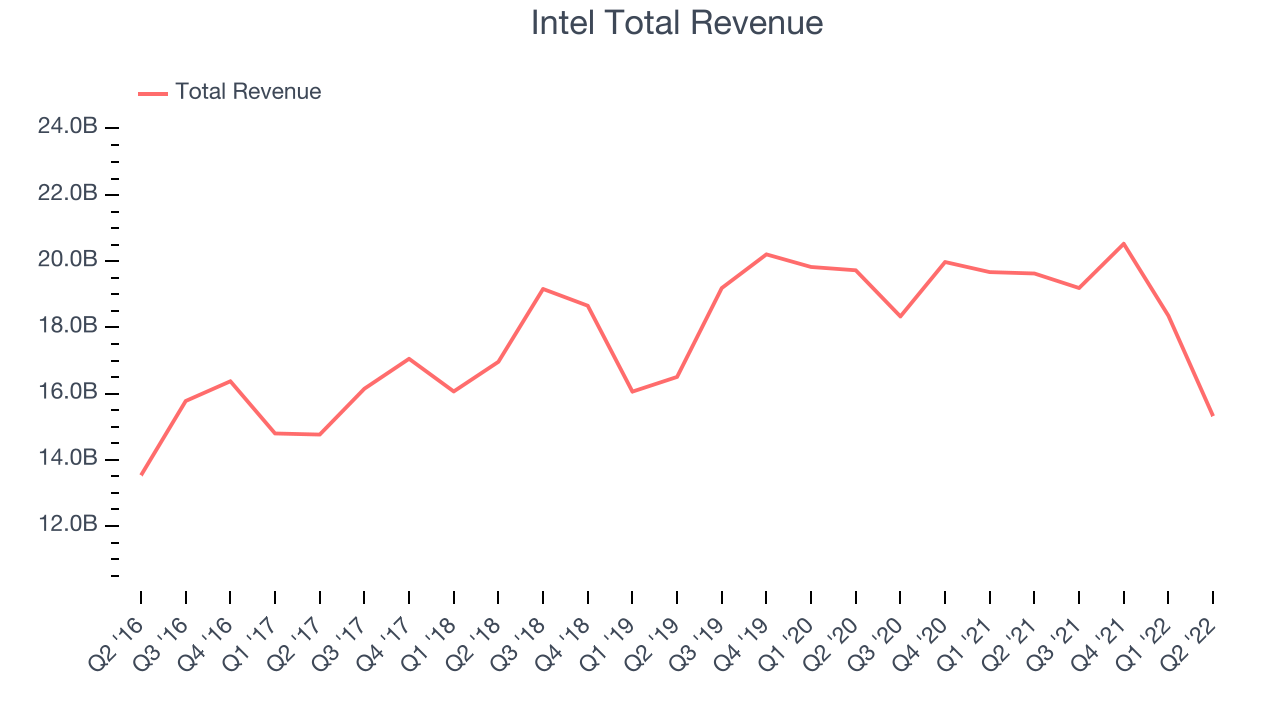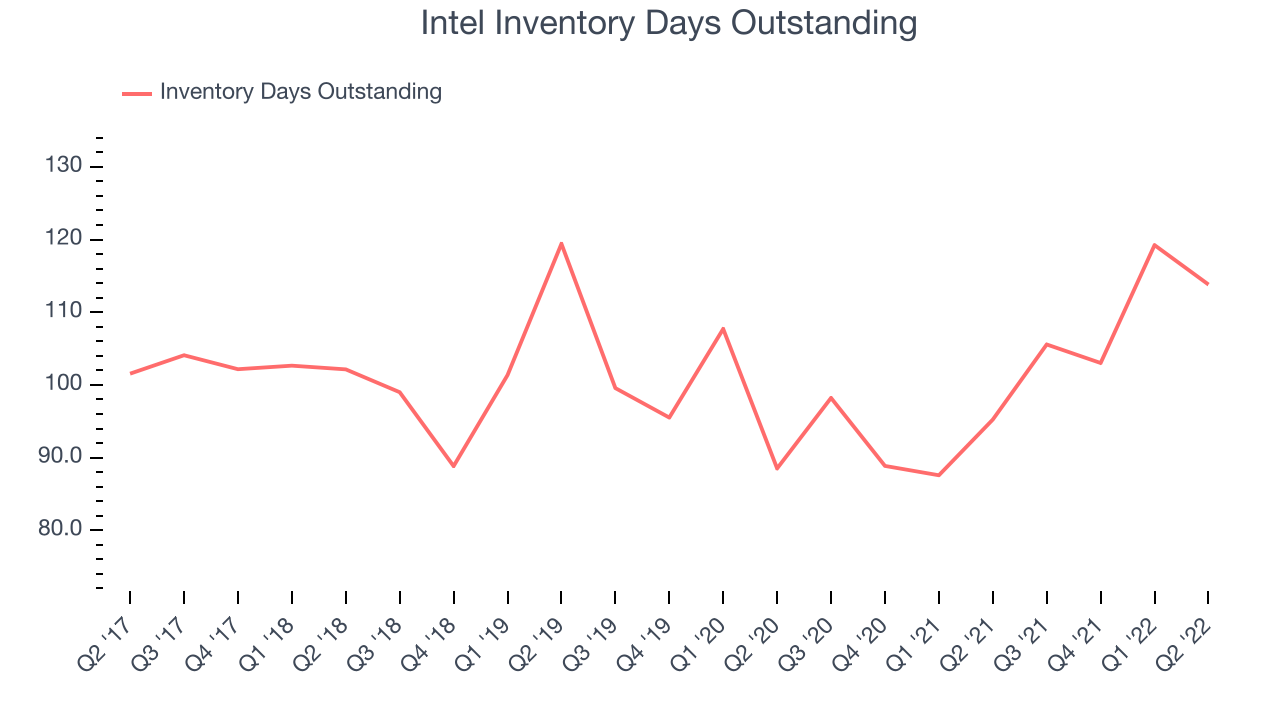Intel (NASDAQ:INTC) Misses Q2 Analysts' Revenue Estimates, Stock Drops
Jabin Bastian 2022/07/28 4:19 pm EDT
Computer processor maker Intel (NASDAQ:INTC) missed analyst expectations in Q2 FY2022 quarter, with revenue down 21.9% year on year to $15.3 billion. Guidance for the next quarter also missed analyst expectations with revenues guided to $15.5 billion at the midpoint, or 16.9% below analyst estimates. Intel made a GAAP loss of $454 million, down on its profit of $5.06 billion, in the same quarter last year.
Is now the time to buy Intel? Access our full analysis of the earnings results here, it's free.
Intel (INTC) Q2 FY2022 Highlights:
- Revenue: $15.3 billion vs analyst estimates of $17.9 billion (14.5% miss)
- EPS (non-GAAP): $0.29 vs analyst estimates of $0.70 (-$0.41 miss)
- Revenue guidance for Q3 2022 is $15.5 billion at the midpoint, below analyst estimates of $18.6 billion
- The company dropped revenue guidance for the full year, from $76 billion to $66.5 billion at the midpoint, a 12.5% decrease
- Free cash flow was negative $6.38 billion, down from positive free cash flow of $5.54 billion in previous quarter
- Inventory Days Outstanding: 114, down from 119 previous quarter
- Gross Margin (GAAP): 36.4%, down from 57% same quarter last year
Intel CEO Pat Gelsinger said the results were "below the standards we have set for the company and our shareholders."
Inventor of the x86 processor that powered decades of technological innovation in PCs, data centers, and numerous other markets, Intel (NASDAQ: INTC) is the leading manufacturer of computer processors and graphics chips.
The biggest demand drivers for processors (CPUs) and graphics chips at the moment are secular trends related to 5G and Internet of Things, autonomous driving, and high performance computing in the data center space, specifically around AI and machine learning. Like all semiconductor companies, digital chip makers exhibit a degree of cyclicality, driven by supply and demand imbalances and exposure to PC and Smartphone product cycles.
Sales Growth
Intel's revenue growth over the last three years has been unimpressive, averaging 1.94% annually. Last year the quarterly revenue declined from $19.6 billion to $15.3 billion. Semiconductors are a cyclical industry and long-term investors should be prepared for periods of high growth, followed by periods of revenue contractions (which can sometimes offer opportune times to buy).

This was a difficult quarter for Intel, with revenue decreasing 22% year on year, missing analyst estimates by 14.6%.
Intel's revenue growth has slowed for the last three quarters and the company expects growth to turn negative next quarter guiding to a 19.3% year on year decline, but before the results Wall St analysts were expecting revenues to grow 3.2% over the next twelve months.
In volatile times like these we look for robust businesses with strong pricing power. Unknown to most investors, this company is one of the highest-quality software companies in the world, and their software products have been the default standard in critical industries for decades. The result is an impressive business that is up an incredible 18,152% since the IPO. You can find it on our platform for free.
Product Demand & Outstanding Inventory
Days Inventory Outstanding (DIO) are an important metric for chipmakers, as it reflects the capital intensity of the business and the cyclical nature of semiconductor supply and demand. In a tight supply environment, inventories tend to be stable, allowing chipmakers to exert pricing power. Steadily increasing DIO can be a warning sign that demand is weak, and if inventories continue to rise the company may have to downsize production.

This quarter, Intel’s inventory days came in at 114, 13 days above the five year average, suggesting that despite the recent decrease the inventory levels are still higher than what we used to see in the past.
Key Takeaways from Intel's Q2 Results
Sporting a market capitalization of $164 billion, more than $27 billion in cash and with positive free cash flow over the last twelve months, we're confident that Intel has the resources it needs to pursue a high growth business strategy.
A highlight was Intel’s improvement of their inventory levels this quarter. That feature of these results really stood out as a positive. On the other hand, it was unfortunate to see that Intel's revenue guidance for the full year missed analyst's expectations. Overall, this quarter's results were not the best we've seen from Intel. The company is down 8.51% on the results and currently trades at $36.32 per share.
Intel may have had a tough quarter, but does that actually create an opportunity to invest right now? It is important that you take into account its valuation and business qualities, as well as what happened in the latest quarter. We look at that in our actionable report which you can read here, it's free.
One way to find opportunities in the market is to watch for generational shifts in the economy. Almost every company is slowly finding itself becoming a technology company and facing cybersecurity risks and as a result, the demand for cloud-native cybersecurity is skyrocketing. This company is leading a massive technological shift in the industry and with revenue growth of 70% year on year and best-in-class SaaS metrics it should definitely be on your radar.
The author has no position in any of the stocks mentioned.